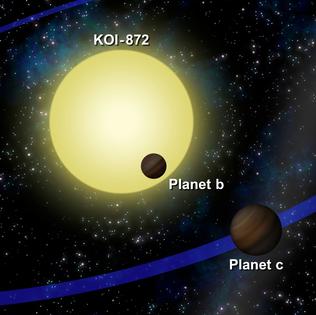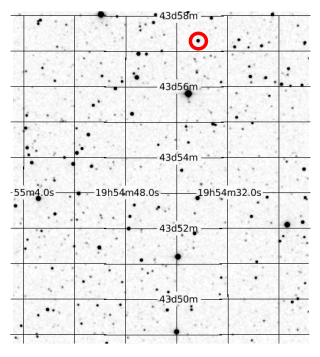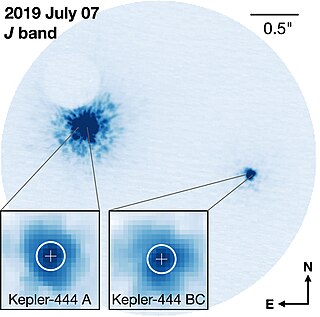Related Research Articles

Kepler-9 is a sunlike star in the constellation Lyra. Its planetary system, discovered by the Kepler Mission in 2010 was the first detected with the transit method found to contain multiple planets.
Kepler-17 is a main-sequence yellow dwarf star that is much more active than the Sun with starspots covering roughly 6% of its surface. Starspots are long-lived, with at least one persisting for 1400 days.
Kepler-39 is an F-type main sequence star located in the constellation Cygnus. It is located about 3,560 light-years away. One known substellar companion orbits it, Kepler-39b.

Kepler-46, previously designated KOI-872, is a star located in the constellation Lyra. Observed since 2009 by the Kepler space observatory, it has since been found to possess a planetary system consisting of at least three planets and while it has a similar mass to the Sun (90%) it is significantly older at ten billion years.
Kepler-80, also known as KOI-500, is a red dwarf star of the spectral type M0V. This stellar classification places Kepler-80 among the very common, cool, class M stars that are still within their main evolutionary stage, known as the main sequence. Kepler-80, like other red dwarf stars, is smaller than the Sun, and it has both radius, mass, temperatures, and luminosity lower than that of our own star. Kepler-80 is found approximately 1,223 light years from the Solar System, in the stellar constellation Cygnus, also known as the Swan.
Kepler-32 is an M-type main sequence star located about 1070 light years from Earth, in the constellation of Cygnus. Discovered in January 2012 by the Kepler spacecraft, it shows a 0.58 ± 0.05 solar mass (M☉), a 0.53 ± 0.04 solar radius (R☉), and temperature of 3900.0 K, making it half the mass and radius of the Sun, two-thirds its temperature and 5% its luminosity.
Kepler-65 is a subgiant star slightly more massive than the Sun and has at least four planets.
Kepler-67 is a star in the open cluster NGC 6811 in the constellation Cygnus. It has slightly less mass than the Sun and has one confirmed planet, slightly smaller than Neptune, announced in 2013.

Kepler-56 is a red giant in constellation Cygnus roughly 3,030 light-years (930 pc) away with slightly more mass than the Sun.
Kepler-88 is a G-type star 1,230 light-years away in the constellation of Lyra, with three confirmed exoplanets. SIMBAD lists a subgiant spectral type of G8IV, while other sources give it a main sequence spectral type of G6V. The latter is more consistent with its properties.

Kepler-25 is a star in the northern constellation of Lyra. It is slightly larger and more massive than the Sun, with a luminosity 21⁄2 times that of the Sun. With an apparent visual magnitude of 10.6, this star is too faint to be seen with the naked eye.

Kepler-26 is a star in the northern constellation of Lyra. It is located at the celestial coordinates: Right Ascension 18h 59m 45.8407s Declination +46° 33′ 59.438″. With an apparent visual magnitude of 15.5, this star is too faint to be seen with the naked eye.
Kepler-102 is a star 353 light-years away in the constellation of Lyra. Kepler-102 is less luminous than the Sun. The star system does not contain any observable amount of dust. Kepler-102 is suspected to be orbited by a binary consisting of two red dwarf stars, at projected separations of 591 and 627 AU.
Kepler-61 is a K-type main-sequence star approximately 1,100 light years from Earth in the constellation Cygnus. It is located within the field of vision of the Kepler spacecraft, the satellite that NASA's Kepler Mission used to detect planets that may be transiting their stars. On April 24, 2013 it was announced that the star has an extrasolar planet orbiting in the inner edge of the habitable zone, named Kepler-61b.

Kepler-138, also known as KOI-314, is a red dwarf located in the constellation Lyra, 219 light years from Earth. It is located within the field of vision of the Kepler spacecraft, the satellite that NASA's Kepler Mission used to detect planets transiting their stars.
Kepler-30 is a star in the northern constellation of Lyra. It is located at the celestial coordinates: Right Ascension 19h 01m 08.0747s Declination +38° 56′ 50.219″. With an apparent visual magnitude of 15.5, this star is too faint to be seen with the naked eye. Kepler-30 is exhibiting a strong starspot activity.
Kepler-28 is a star in the northern constellation of Cygnus., It is orbited by two exoplanets. It is located at the celestial coordinates: Right Ascension 19h 28m 32.8905s, Declination +42° 25′ 45.959″. With an apparent visual magnitude of 15.036, this star is too faint to be seen with the naked eye.
Kepler-43, formerly known as KOI-135, is a star in the northern constellation of Cygnus. It is located at the celestial coordinates: Right Ascension 19h 00m 57.8034s, Declination +46° 40′ 05.665″. With an apparent visual magnitude of 13.996, this star is too faint to be seen with the naked eye. The Kepler-43 has a very strong starspot activity.

Kepler-186 is a main-sequence M1-type dwarf star, located 177.5 parsecs away in the constellation of Cygnus. The star is slightly cooler than the sun, with roughly half its metallicity. It is known to have five planets, including the first Earth-sized world discovered in the habitable zone: Kepler-186f. The star hosts four other planets discovered so far, though they all orbit interior to the habitable zone.

Kepler-444 is a triple star system, estimated to be 11.2 billion years old, approximately 119 light-years (36 pc) away from Earth in the constellation Lyra. On 27 January 2015, the Kepler spacecraft is reported to have confirmed the detection of five sub-Earth-sized rocky exoplanets orbiting the main star. The star is a K-type main sequence star. All of the planets are far too close to their star to harbour life forms.
References
- 1 2 3 4 5 Vallenari, A.; et al. (Gaia collaboration) (2023). "Gaia Data Release 3. Summary of the content and survey properties". Astronomy and Astrophysics. 674: A1. arXiv: 2208.00211 . Bibcode:2023A&A...674A...1G. doi: 10.1051/0004-6361/202243940 . S2CID 244398875. Gaia DR3 record for this source at VizieR.
- ↑ McQuillan, A.; Mazeh, T.; Aigrain, S. (2013). "Stellar Rotation Periods of The Kepler objects of Interest: A Dearth of Close-In Planets Around Fast Rotators". The Astrophysical Journal Letters. 775 (1). L11. arXiv: 1308.1845 . Bibcode:2013ApJ...775L..11M. doi:10.1088/2041-8205/775/1/L11. S2CID 118557681.
- ↑ "KOI-1958". SIMBAD . Centre de données astronomiques de Strasbourg . Retrieved 14 February 2018.


